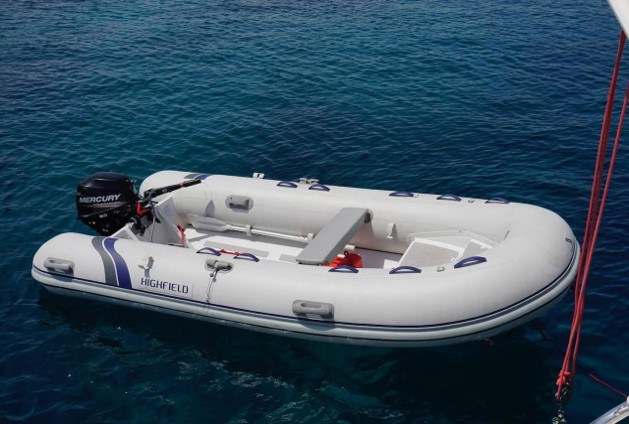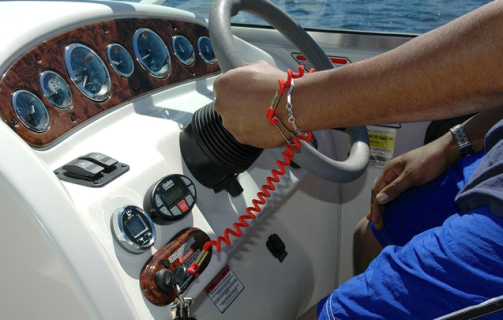Circle of Death: Dinghy Out of Control
Circle of Death
“From the CCA School of Hard Rocks
...lessons learned in pursuit of the Art of Seamanship”
As told to Brian Guck, Boston Station, September 2022
This is a true story shared with me, Brain Guck, by a friend in Pulpit Harbor, ME. The author, an experienced sailor and mountaineer, had just returned from a successful trip to the summit of Mt. Everest.
I hopped into our motor dinghy and headed out to the boat to do some routine chores. Once completed, I got back in the dinghy and headed back to the dock.

Planing inflatables in particular can toss the driver in the drink due to their high speeds, great maneuverability, and light weight. The red emergency engine cutoff switch lanyard can be seen on this front of this tiller-steered outboard. Photo: Chuck Hawley |
It was low tide. I needed to navigate shallow water to get to my usual tie up spot. I did what I frequently do in this situation, turning around to lift the idling motor into the shallow water setting. The new motor we bought this year doesn’t raise and lower quite as easily as our old one did, so I had to jiggle the motor to get it to lock into position. As I did this, the motor tiller brushed the side of the dinghy and jerked into full throttle. The dinghy surged forward, then swerved violently to starboard. I was thrown from the dinghy into the shallow water.
Outboard motors are sold with “kill switches”[1]. These are rubber lanyards intended to be worn around the operator’s wrist, with the other end connected to a switch on the motor. If the operator is inadvertently thrown into the water, the lanyard pulls the switch and immediately shuts off the motor.
 |
|
Console-type boats may have the emergency cutoff switch integrated with the engine key switch. Attaching the lanyard to your shoelaces may prevent entanglement in the wheel. US Coast Guard photo. |
These kill switches are designed to avoid one of the most dangerous situations in motor boating. If an operator is thrown overboard with the motor running, the motor jerks immediately to one side and causes the boat to start spiraling in circles. It is almost impossible for a person in the water to get out of the path of an oncoming motor boat, and the rapidly rotating propeller can easily shred human bodies. This situation is widely known as “the circle of death”. However, few boat operators bother to actually use kill switch lanyards. The lanyards are mildly cumbersome and the risk of an accident is low. Unfortunately, I was not wearing a lanyard.
I now faced the circle of death. I stood up in waist deep water, turned, and saw the dinghy coming straight at me, full throttle. In the seconds available, I had two clear thoughts: “this may be it”, and “I must get as low as I can”. The water was shallow and the dinghy was almost on top of me. I submerged as much as possible, my back on the ocean floor. The dinghy passed over me, motor screaming, circling hard to the right as it did.
I resurfaced, trying to assess how badly I was hurt, and realized I had to get out of the way of the dinghy’s next pass. I grabbed onto another boat tied to the dock and held it to me as a shield. Eventually the circling dinghy ran itself onto the rocky beach. My legs were bleeding profusely in multiple places.
It feels a miracle that I escaped serious injury or death. The propellor blades passed over my right thigh, making five parallel cuts. But the propeller was just high enough, and I was just deep enough that the cuts were shallow. One blade cut more deeply on my left knee, but the cut was clean. As the doctor who stitched me up said, “you are incredibly lucky you aren’t in surgery right now, with us trying to save severed muscles or limbs, or worse”. If the dinghy hadn’t turned exactly when it did, the blades would have hit me in the face.
My cuts will heal in a couple of weeks. For now, the bigger problem is contusions in my legs, caused by the propeller shaft and metal boat bottom slamming into them. Walking is a real challenge. This too shall heal soon. I am beyond fortunate.
This really spooked me. It was an incredibly close call. Nothing I have encountered in the mountains compares.
I pride myself in carefully managing risk, in the mountains and on the water. I have spent a lifetime doing so. But I lapsed, and almost paid a severe price. It is a fine line we all tread, often not realizing it.
Friends, wear those lanyards, or seatbelts, or whatever. And let us be grateful for every moment we get to inhabit this good earth.”
The Cruising Club of America is a collection of passionate, seriously accomplished, ocean sailors making adventurous use of the seas. All members have extensive offshore boat handling, seamanship, and command experience honed over many years. “School of Hard Rocks” stories, published by the CCA Safety and Seamanship Committee, are intended to advance seamanship and help skippers promote a Culture of Safety aboard their vessels
[1] While commonly called “kill switches” the Coast Guard and NASBLA refer to these as Engine Cutoff Switches, or ECOS, and they are now required to be worn when the vessel is equipped with one.





